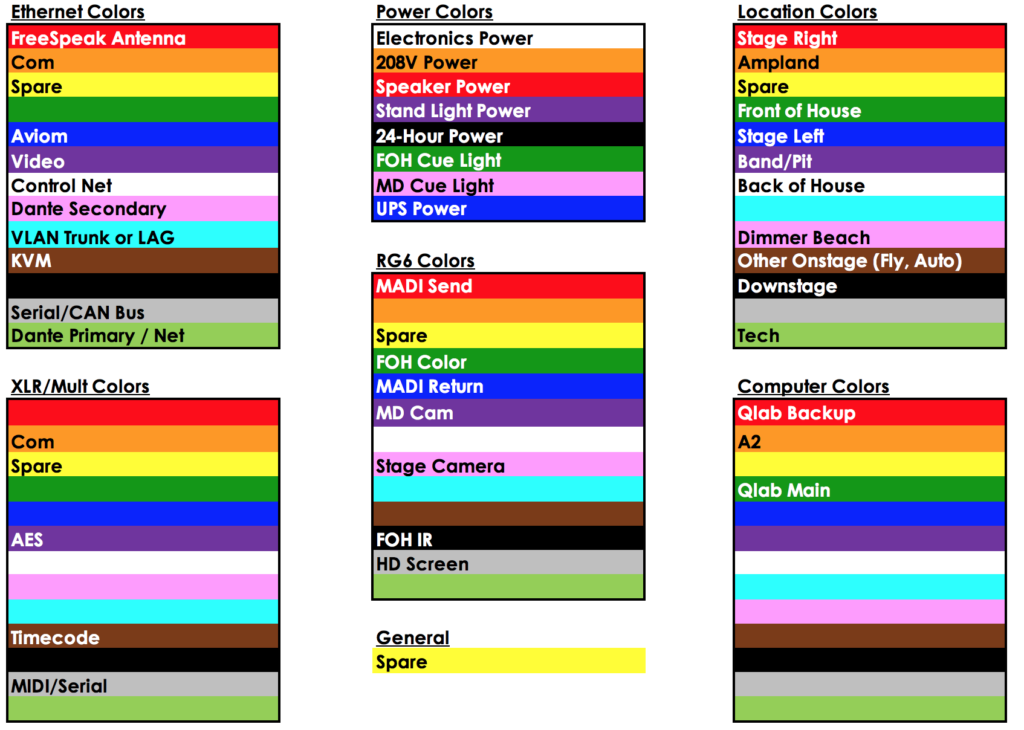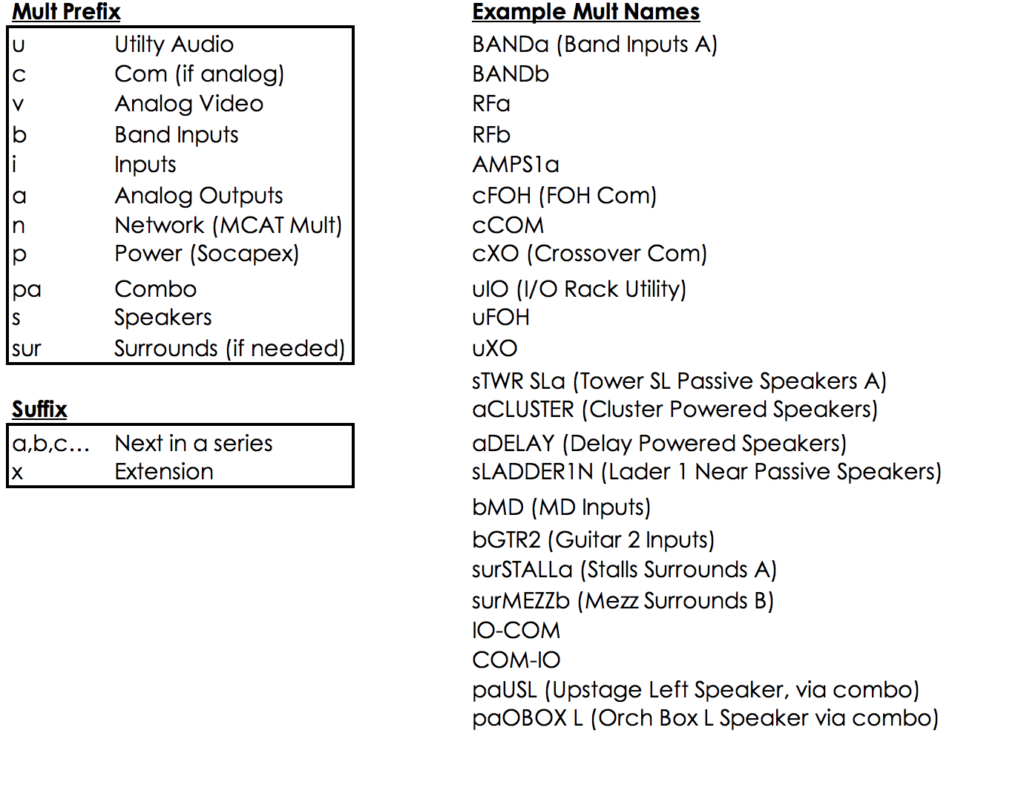There are a lot of ways to approach cabling sound systems, but since this has come up among Minotaur users and students, here are my notes on what’s worked for me.
Color Coding
Color coding can be helpful, but shouldn’t be the only way of differentiating two cables, since it’s ambiguous in low lighting and for colorblind technicians. The most important thing for me is differentiating signal types that use the same type of connectors, discouraging users from plugging things in a way that can cause damage. For instance, intercom analog mult and XLR are all orange to discourage getting mixed with signal. Cue light and stand light power are different colors than other power in the sound system. FreeSpeak Antennas on Ethercon are different than analog video on Ethercon are different than LAN are different than MADI are different than KVM.
It’s useful to have all spare cables be the same color, and yellow seems to already be accepted across many roadhouses and commercial teams in New York, both for electrics and sound, so I use yellow.
Next, it’s helpful to differentiate similar cables at each rack on tour, e.g., each band mult might be a different color, and each NL4 in a bundle of several NL4s might be a different color.
Here’s where I start, updating for the needs of each show:
Cable Naming
For most cables, abbreviation and numbering schemes are unnecessary and difficult to remember. I generally type the location, then the signal, e.g., “SM Com” or “FOH UPS Power,” which helps crew members seeing the cables for the first time.
Mults sometimes need shorter names, since about ten characters fit on mult tail labels. Here’s where I start:
Bundles
The combined cross-sections of cables in a bundle generally become unwieldy at larger than 1.5 square inches. It’s difficult to bundle more than eight cables, though we might make exceptions for long runs on tour. If we removed the connectors and melted the cable of a tightly-packed roadcase, the cable generally fills around 30% of the total volume of the case, so I plan west-coast roadcases at 27% and east-coast roadcases at 23%. Minotaur can help bundle and box planning by calculating cross-section area and box volume ahead of time.
Lengths and Paths on Tour
If the cable package can accommodate the Majestic in San Antonio, the Arsht in Miami, the Nederlander in Chicago, the Civic Center in Des Moines, the Fox in Detroit and St. Louis, and the Keller in Portland, it’s probably OK everywhere.
Where an extension is necessary, I’d prefer to have exactly one extension per bundle, and to always have the extension shorter than the main bundle. For instance, the cluster cable run will be 300′ if the production plays San Antonio or Chicago, so I would prefer to have a 200′ + a 100′ — even though in most cases a 150′ is plenty for the center cluster, it’d be a little annoying to run a 150′ extension to extend 25′ on the day when it’s 175′ a total run, and I’d prefer to not keep track of a 150′, 100′, and 50′.
| Run | Length | Ext | Notes |
| FOH | 250 | 100 | 350′ Des Moines Ceiling, 350′ Wang SR Include mezz rail cameras and monitors as separate cables in FOH bundles for Des Moines / Costa Mesa / Starlight |
| Ampland > Pit | 150 | 100 | Portland South Wing is 200′. San Antonio might be 250′. In most cities, 100′ is probably enough. |
| Ampland > US Band (DEH) | 200 | 100 | 200 Far, 100 Near. Could be 150′ + 100′, ask crew |
| Ampland > Drums | 200 | 100 | 200 Far, 100 Near. Could be 150′ + 100′, ask crew |
| Automation | 100 | 50 | |
| Cross Stage (Under) | 150 | 100 | Arsht |
| Cross Stage (Deck) | 150 | 50 | Could probably just be 100′ + 50′, except for San Antonio |
| LX Distro | 200 | 50 | 200′ for far, 50′ for near, with ability to combine. |
| Far Tower | 150 | 50 | Miami Arsht is 200′ under, San Antonio Majestic is 200′ on ground or 250′ if PA is flown. 100′ works many places. Could probably be 100′ + 50′ for tours with cable run on deck that don’t play San Antonio. Or send a single 100′ tower extension. |
| Near Tower | 100 | 50 | Towers could be 50, 100, and 150 to serve both towers in any theatre if running on deck This might be 200′ San Antonio Majestic. |
| Cluster | 200 | 100 | Nederlander / Majestic 300′. Or 200 + 100. For a one-nighter with cable swags, 150 + 50 is probably enough. Provide method to split cluster in low-trim houses? |
| Balcony Rail Speakers | 200 | 100 | 300 to center box in St. Louis |
| Balcony Rail Video | 200 | 100 | For Des Moines there needs to be a duplicate way to split front of house between the house booth and the Cove E catwalk – either include FOH cameras in FOH bundles with a 100′ extension from mix position, or make balc rail bundle 350′ total to get to house mix position. Run to Cove E is either 200′ or 250′ |
| Balc Rail TVs | 50 | 50 | From center. Des Moines Catwalk drop is 100′ branches |
| Underbalcs | 25′, 50′, 50′, 75′ | ||
| LX Op | 250 | 50 | Can cable 250 from crossover or ampland, 50 from FOH, with ability to combine |
| SM Office | 200 | 100 | Make available in XO rack. Get wired internet from SM office to sound system |
| Spot Booth | 250 | 150 | Fox Detroit? |
| Fly Rail | 100 | 50 | Could be just 100′ if crossover rack is always on fly side. Build as long and short? |
| SM Desk | 50 | 100 | Short / Long or Short + Long – Portland South Wing and Trap Room Setups |
| Remote RF Rack | 150 | Academy of Music, Nederlander. Could be 100′ + 50′. | |
| House Ties | 50 | ||
| Ladder Far | 200 | From Dimmer Distro. Check with electrician. | |
| Overhead | 150 | From Dimmer Distro. Check with electrician. | |
| Ladder Near | 150 | From Dimmer Distro. Check with electrician. |
Miscellaneous Notes
I like to avoid tail-to-tail connections in racks, since they’re often difficult to troubleshoot without cutting zip ties. I usually do this by using mult panels for the ampland utility mults, e.g., the mult between the com and IO rack. That way, mults that plug into some devices in the com rack and some in the IO rack, like SM mults, have an easy place to unplug and troubleshoot.
In mults with signal flowing in both directions, like an SM mult, I like to have the primary direction starting at pair 1 and ascending, and the secondary direction starting at the highest pair and descending.


